
TOUR REGISTRATION IS CLOSED!
This Sacred Sites Journey to ENGLAND is a
go!
Our spiritual journey begins on August 6, 2016
as our group
gathers at London Heathrow Airport to transfer to Glastonbury.
The main
journey ends on August 13th and the Cornwall extension ends of August 16th.
Due to numerous requests, we're
considering offering another Sacred Sites Journey to England in 2017!
Tentative Dates: September 23 - October 1, 2017.
Please email
info@SacredSitesJourneys.com
if you're interested.

Experience and explore some of the most powerful sacred sites on
Earth during this spiritual pilgrimage
to Stonehenge (Private Entrance inside the circle!), Glastonbury - the Isle of Avalon,
Avebury,
Silbury Hill, West Kennett Longbarrow and more!
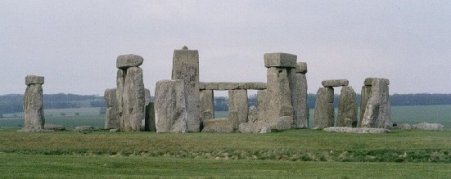
Experience the powerful
energies and
understand the esoteric significance
of the mysterious stone circles and other power spots
that will come alive for you, as you walk the ancient pathways
and connect with the rich legacy of the Celtic Goddess Tradition and its Avalonian
Mysteries.
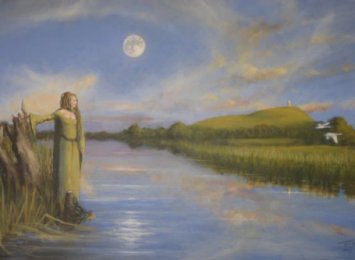
Participate in meditations and sacred ceremonies to
connect with this ancient land, the Ancestors & the Divine Feminine!
 PRIVATE
ENTRANCES PRIVATE
ENTRANCES
STONEHENGE - Inside the circle!
NOTE: Normally if you visit Stonehenge, you walk around
the circle on a walkway many feet away from the stones.
Through joining a group such as ours you are able to be inside the circle to experience
their powerful energies!
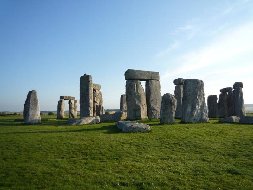 GLASTONBURY: The Chalice Well, fountainhead of the Red
Spring
GLASTONBURY: The Chalice Well, fountainhead of the Red
Spring
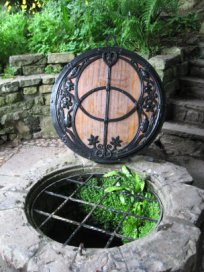
GLASTONBURY:
The Well House for the White Spring

GLASTONBURY: Goddess Temple with Lynne Orchard, Priestess of Avalon
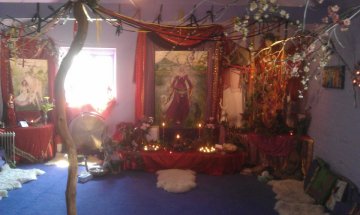
BATH: Private Entrance into the Cross Bath
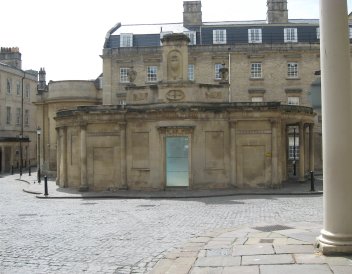
OTHER
SACRED SITES YOU'LL EXPERIENCE:
WILTSHIRE
World-famous
Avebury, Silbury Hill and West Kennett Longbarrow, all a part of the ancient temple
landscape
of the Salisbury Plain, where you will experience the powerfully transformative and
palpable energies
that have endured at these ancient sites for centuries!
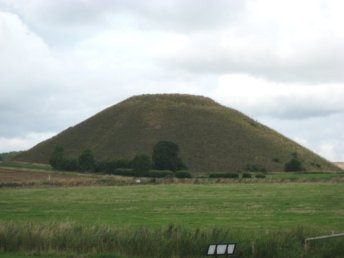
GLASTONBURY & Nearby
Glastonbury
Tor - Transcend the veil of time and place and connect with the lingering energies
from ancient Avalon!
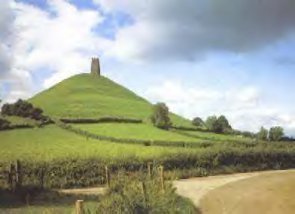
Glastonbury
Abbey
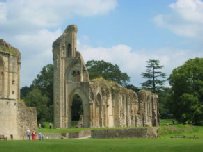
Option:
WearyAll Hill and Bride's Mound

Cadbury
Castle - Camelot
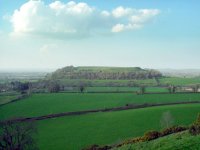
BATH
Walking Tour of
the older parts of the Georgian city center

Entrance into the Roman Baths
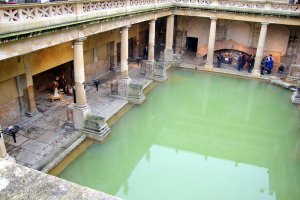
CORNWALL
EXTENSION to TINTAGEL & BOSCASTLE
Tintagel Castle, the legendary birthplace of King Arthur
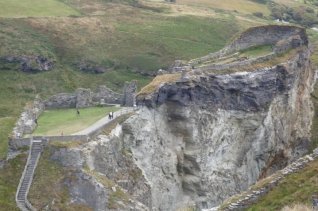
Arthur’s Hall of Chivalry
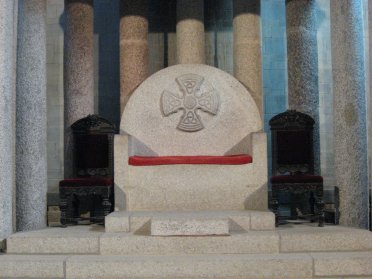 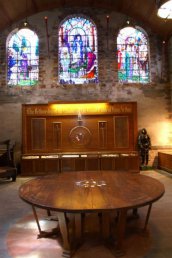
Merlin’s
Cave
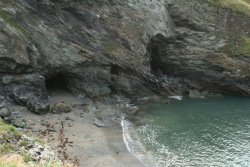
St. Nectan’s Glen
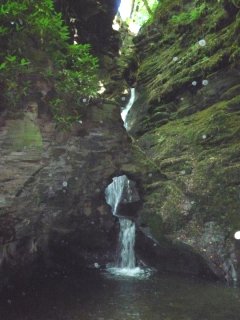
Boscastle: Witchcraft Museum
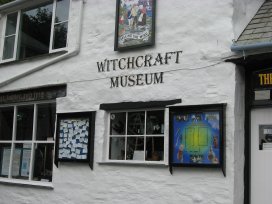

PERSONNEL
Spiritual Tour Guide & Ceremonialist: Michael
Orchard
Researcher/Teacher of the Goddess Tradition & Ancient Megalithic History

 
Michael has lived and worked in Glastonbury,
otherwise known as The Isle of Avalon, for over 30 years. He has always had a
love for the ancient history of the place and all the myths and
legends associated with it. Over the years Michael has visited many sacred and
historical sites throughout the British Isles, and is fascinated by the cultures of
the ancient people of these lands.
For many years, Michael together with his wife Lynne, was the Guardian of
one of Britain’s most well known and sacred sites, the famous Chalice Well
Gardens in Glastonbury, one of the legendary resting places of the Holy Grail.
Here Michael personally welcomed thousands of pilgrims from around the globe, and helped
them to understand and to feel the special energies and legends of the holy well and its
healing waters.
Michael is a good communicator, and on his tours brings the history alive
through a skillful combination of myth, history, and local folklore
seasoned with some good West Country English humor.
Michael is also an accomplished Ceremonialist and will be facilitating
ceremonies during our spiritual pilgrimage at the sacred sites that he knows and loves.
Michael’s philosophy of tour guiding is to give his groups some
background information and then to allow folks to feel the energies and the spirit of the
place themselves. There is always time to sit under a tree, to touch an ancient standing
stone, to have a prayer or a wish, or to dowse some earth energies. And after all the
excitement of a new place, there is usually time for a cup of tea or a spot of retail
therapy as well! Michael looks forward to meeting you and guiding you through some of the
wonders of ancient Britain!
Ceremonialist: Lynne Orchard
Priestess
of Avalon
 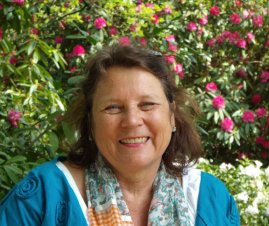 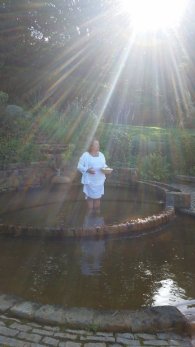
Lynne
Orchard is a Priestess of Avalon who lives in Glastonbury. She has been a
Priestess since 2002. She became an honorary Priestess after being the Guardian
of the sacred Chalice Well in Glastonbury for many years. In her
time as Guardian of the Well, Lynne, together with her husband Michael conducted many
sacred ceremonies, celebrating the wheel of the year, handfastings, blessings, rites of
passage, naming ceremonies, and initiations. Since leaving the Well in 2005 Lynne has
continued to do ceremonial work and to deepen her connection with the
Isle of Avalon and to honor the presence of the Goddess and divine feminine within the
landscape.
Lynne also works deeply with people as a therapist, helping her clients
find their wholeness and integrity through a spiritual approach to grounded
bodywork. She works primarily with essential oils and massage, and with
craniosacral therapy.
Lynne has traveled to many sacred places in the world and her core belief
is to honor the earth and all living beings as a manifestation of the
divine play. Lynne uses ritual and ceremony to invite you to join her in
entering the world of the Goddess and to embark on a journey of deep transformation.

ITINERARY
August 6 - 13, 2016
Day 1. Saturday, August 6. Arrive Heathrow;
Group Transfer to Glastonbury:
Group Meeting; Welcome Dinner (D)
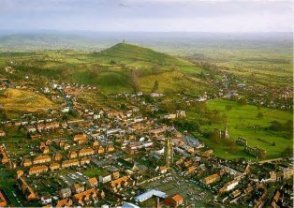 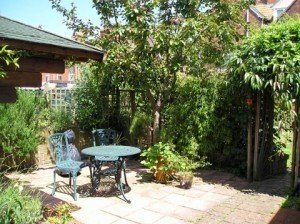 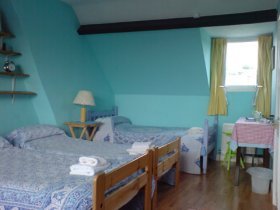 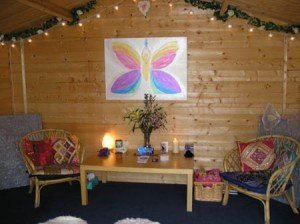
L to R: Aerial view of Glastonbury, Pilgrim's B and B - Garden,
Room, Meditation Room
This Sacred Sites Journeys tour is LAND ONLY. You are responsible to book
your international flights to and from London's Heathrow International Airport. IMPORTANT:
Please book your flight to arrive by 8:00AM, so that you will have time to clear
Immigration, Baggage Claim and Customs and transfer to Terminal 5 (if you do not
arrive there) for our 11:00AM group meeting and transfer. NOTE: If you’re not able to
arrive by 8:00AM, we suggest that you fly in a day early. There are several airport hotels
where you can spend the night. This will also assist you to overcome jet lag and be rested
for the beginning of your spiritual journey.
Upon arrival at Heathrow clear Immigration, claim your bags
and exit through Customs. Meet the group and Tour Guides Michael and Lynne Orchard
in the Arrivals Hall in Terminal 5 (full details to be announced in the final tour
itinerary, which will be emailed to the group 2 weeks to 10 days before the journey begins).
We board our motor coach for our drive through the English countryside. We'll stop along
the way for lunch on your own with the group.
Arrive mid-afternoon in mystical Glastonbury - fabled Avalon!
For centuries it has been the gathering place for those following the ancient Druid
and Celtic traditions honoring the Divine Feminine. The Goddess is definitely
alive in Glastonbury! In the sacred landscape Her body is the soft rounded hills. Her love
will whisper to your heart and be your source and inspiration as it enfolds you during
your time here. The small town of Glastonbury still preserves its long history and rich
traditions, along with a uniquely blended atmosphere of modern times. People are pulled
here from all over the world by a special something...just like you have been.
On our
arrival we check in at charming Pilgrims Bed and Breakfast, located a
two-minute walk from the heart of downtown. We've been using this B & B for our
groups for the last 8 years. They operate a non-smoking, ’shoe-free’ house, so
please feel free to bring your slippers to keep your toes warm. A sheltered smoking area
is available in the garden. They have a ‘come and go as you please’ policy and
provide front door keys for all the rooms. Free Wi-Fi is available throughout the house
and gardens. All rooms are en-suite with their own shower. All
rooms are warm and comfortable, with hairdryers and tea/coffee-making facilities, plus
little extras which makes you feel at home.
Facilities: The focal point of the house is the kitchen with its large
dining table, where you can gather for tea, tarot readings, and great visits with others
in the group. They also have a guest lounge with sofas, an open fireplace, TV and small
library. For hungry pilgrims, a guest fridge with drinks and chocolate is always available
in the hallway. Extensive local information is on hand and original artwork by notable
local artists is on display.
Gardens and ‘The Sanctuary": The beautiful gardens are always
available for your use, with a rock pool and garden seats scattered around where you can
sit and relax with friends old or new, or quietly meditate. Despite the proximity to
Glastonbury center, the B & B is blessed with a quiet, tranquil location, making the
gardens a wonderful place to just ‘be’. Tucked away is the secret garden, great
to sit and meditate or to process all you have learnt on your pilgrimage in Glastonbury.
The Sanctuary, a large Meditation Room within the gardens is available for individual or
group meditation and is also used for individual and group therapy and healing sessions.
Take some time to get settled in your space and rest. In the later
afternoon we'll gather for our Introductory Group Meeting/
Sharing Circle with our Guide Michael Orchard and Priestess
of Avalon Ceremonialist Lynne Orchard. Michael will offer a short
introduction to Glastonbury and Her myths and legends, in preparation for our time here
during the coming week.
Afterwards
we enjoy our Welcome Dinner at a local restaurant. We'll have a chance to begin getting
to know each other a bit by sharing our stories of how and why we've come to be here. Overnight
Glastonbury. Pilgrims Bed & Breakfast.
Day 2. Sunday, August 7. Glastonbury Tor & The Abbey (B)
 
L to R: Glastonbury Tor, The Abbey
This morning we're off to Glastonbury Tor.
Rich in legend and mythological associations, the Tor may have been a place of ancient
ritual. Today, it is still a destination for spiritual seekers. The terracing on the
slopes of the Tor may be the remains of an ancient observatory, a
seven-tiered sacred mount, a great three-dimensional labyrinth,
a ceremonial way to the Otherworld. At the top of the Tor stands the remains of
the Medieval St. Michael's Church, dedicated to Archangel Michael. We take the
footpath to the top to enjoy its sweeping view of the Somerset countryside. Take time to
gaze at the landscape; you can see for miles. Though the Tor is a majestic hill rising
enigmatically above the flat surrounding meadows, it's no ordinary hill! Some say
it's home to the King of the Fairies, Gwyn ap Nudd, a psychopomp who helps those who cross
over to the Otherworld. Centuries of legends and folklore about the Tor all arrive at the
same conclusion: it is a place where the veil between the worlds is thin. You will have
time for individual meditation to connect to
these powerful energies.
Return to town. Lunch on your own.
After lunch enjoy a guided tour of Glastonbury Abbey with Michael. Set in 37 acres of
beautifully peaceful parkland in the center of town the Abbey was built in the Middle Age.
It's described by some historians as "the holiest place in all of England". St
Mary's Chapel marks the site where Joseph of Arimathea established the first above-ground
church in all of Christendom. The Celts had a deity named Easus who died and was supposed
to come back to life. When they heard about Jesus from Joseph of Arimathea, they saw the
return of Easus in the story, and gave Ynys Witrin, or Glastonbury, to him as a site for a
church. This was the birthplace of Celtic Christianity, and grew to be a powerful
pilgrimage site. Many people believe that the Holy Thorn tree that can be seen in the
grounds originated from Joseph of Arimathea's staff. Graves thought to be those of Arthur
and Guinevere have been unearthed here. We'll wander the ancient grounds with Michael,
exploring their mysteries. You'll also have some time for individual
reflection and meditation.
The remainder of the afternoon and evening is free time. Dinner on your own. There are several excellent restaurants in the center of
town, just a few minutes walk away, that offer varied ethnic cuisines. Overnight
Glastonbury. Pilgrims Bed & Breakfast.
Day 3. Monday, August 8.
Bath: Walking Tour, Cross Bath Private Entrance, Roman Baths (B)
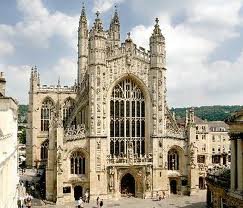
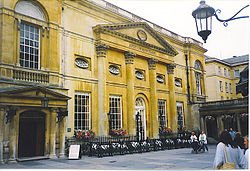
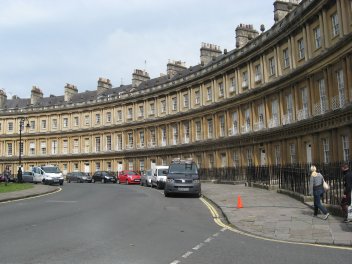 
L to R: Bath Abbey, the Pump Room, the Circus, the Cross Bath

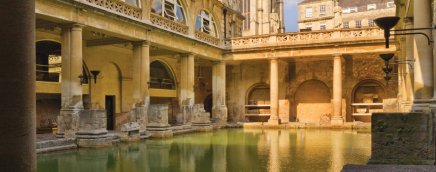
L to R: The Royal Crescent, the Roman Baths
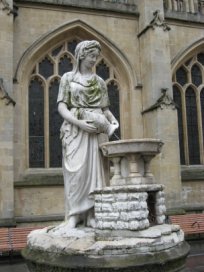
Statue of Sulis/Minerva
Depart later morning for Bath, a World
Heritage Site since 1987. The city has a variety of theaters, museums, and other
cultural and sporting venues. Upon arrival enjoy
lunch on your own. Then Michael will lead a walking tour
of the city, which may include some of the following:
The Abbey Church of Saint Peter and Saint Paul, commonly known
as Bath Abbey, is an Anglican parish church and a former Benedictine
monastery. Founded in the 7th century, Bath Abbey was reorganised in the 10th century and
rebuilt in the 12th and 16th centuries; major restoration work was carried out by Sir
George Gilbert Scott in the 1860s. It is one of the largest examples of Perpendicular
Gothic architecture in the West Country. The church is cruciform in plan, and is able to
seat 1200. An active place of worship, with hundreds of congregation members and hundreds
of thousands of visitors each year, it is used for religious services, secular civic
ceremonies, concerts and lectures. The choir performs in the abbey and elsewhere. There is
a heritage museum in the vaults. The abbey is a Grade I listed building, particularly
noted for its fan vaulting.
The heart of the Georgian city was the Grand Pump Room in the Abbey
Church Yard. It's been designated as a Grade I listed historic building. The main block,
built of Bath stone, was begun in 1789 by Thomas Baldwin. It was finally finished in 1799.
The facade of the building features Corinthian half columns. The North Colonnade of 9
bays, with unfluted Ionic columns, was built by Baldwin in 1786. The South Colonnade is
similar but had an upper floor added in the late 19th century. The colonnades and side
wall of the Pump Room have a facade on Stall Street. Situated next to main street entrance
to the Roman Baths, you can sample the waters from the warm spring which fills the Roman
Baths. The building also houses a restaurant, where you could sample the afternoon tea.
The Circus consists of three long,
curved terraces designed by the elder John Wood to form a circular space or theatre
intended for civic functions and games. The games give a clue to the design, the
inspiration behind which was the Colosseum in Rome.[153] Like the Colosseum, the three
façades have a different order of architecture on each floor: Doric on the ground level,
then Ionic on the piano nobile and finishing with Corinthian on the upper floor, the style
of the building thus becoming progressively more ornate as it rises.
The most spectacular of Bath's terraces is the Royal Crescent, built
between 1767 and 1774 and designed by the younger John Wood. But all is not what it seems;
while Wood designed the great curved façade of what appears to be about 30 houses with
Ionic columns on a rusticated ground floor, that was the extent of his input. Each
purchaser bought a certain length of the façade, and then employed their own architect to
build a house to their own specifications behind it; hence what appears to be two houses
is sometimes one. This system of town planning is betrayed at the rear of the crescent:
while the front is completely uniform and symmetrical, the rear is a mixture of differing
roof heights, juxtapositions and fenestration.
Later this afternoon visit the Roman Baths complex, a
well-preserved Roman site for public bathing. The Roman Baths themselves are below the
modern street level. There are four main features: the Sacred Spring, the
Roman Temple, the Roman Bath House and the Museum
holding finds from Roman Bath. The buildings above street level date from the 19th
century.
History: The first shrine at the site of the hot springs was built by
Celts, and was dedicated to the goddess Sulis, whom the Romans identified
with Minerva. Geoffrey of Monmouth in his largely fictional Historia
Regum Britanniae describes how in 836 BCE the spring was discovered by the British king
Bladud who built the first baths. Early in the 18th century Geoffrey's obscure legend was
given great prominence as a royal endorsement of the waters' qualities, with the
embellishment that the spring had cured Bladud and his herd of pigs of leprosy through
wallowing in the warm mud.
Roman use: The name Sulis continued to be used after the Roman invasion,
leading to the town's Roman name of Aquae Sulis ("the waters of Sulis"). The
temple was constructed in 60-70 CE and the bathing complex was gradually built up over the
next 300 years. During the Roman occupation of Britain, and possibly on the instructions
of Emperor Claudius, engineers drove oak piles to provide a stable foundation into the mud
and surrounded the spring with an irregular stone chamber lined with lead. In the 2nd
century it was enclosed within a wooden barrel-vaulted building, and included the
caldarium (hot bath), tepidarium (warm bath), and frigidarium (cold bath). After the Roman
withdrawal from Britain in the first decade of the 5th century, these fell into disrepair
and were eventually lost due to silting up, and flooding. The Anglo-Saxon Chronicle
suggests the original Roman baths were destroyed in the 6th century.
Redevelopment: The baths have been modified on several occasions,
including the 12th century when John of Tours built a curative bath over the King's Spring
reservoir and the 16th century when the city corporation built a new bath (Queen's Bath)
to the south of the Spring. The spring is now housed in 18th century buildings, designed
by architects John Wood, the Elder and John Wood, the Younger, father and son. Victorian
expansion of the baths complex followed the neo-classical tradition established by the
Woods. In 1810 the Hot Springs failed and William Smith opened up the Hot Bath Spring to
the bottom, where he found that the spring had not failed but had flowed into a new
channel. Smith restored the water to its original course and the Baths filled in less time
than formerly.
Conservation: The late 19th century carvings of Roman Emperors and
Governors of Roman Britain on the terrace overlooking the Great Bath are particularly
susceptible to the effect of acid rain and are being protected with a wash of a
sacrificial shelter coat every few years. Exhibits within the temple precincts are
susceptible to warm air which had the effect of drawing corrosive salts out of the Roman
stonework. To help reduce this, a new ventilation system was installed in 2006. In 2009 a
grant was made to Bath and North East Somerset Council to contribute towards the cost of
re-developing displays and improving access to the Roman Baths, by the Department for
Culture, Media and Sport/Wolfson Fund, which was established to promote improvements in
Museums and Galleries in England.
We have a private booking for our group at the Cross Bath.
This historic pool for bathing was rebuilt, in the style of Robert Adam by Thomas Baldwin
around 1789 and is designated by English Heritage as a Grade I listed building. The warm
water spring was possibly used before the nearby Roman Baths were developed. The name is
believed to commemorate the body of St Aldhelm resting there on its journey from Doulting
to Malmesbury Abbey in 709. The healing powers of the bath were one of the reasons for the
foundation of St John's Hospital, around 1180, by Bishop Reginald Fitz Jocelin and is
among the oldest almshouses in England. In the 16th, 17th and 18th centuries the baths
were frequently visited by royalty, increasing their popularity. In June 1688, Mary of
Modena, James II's wife, gave birth to a son, Prince James nine months after bathing in
the Cross Bath. The Melfort Cross, was erected in 1688 to celebrate the birth. The bath
was refurbished in the 1990. We have 90 minutes to relax in the thermal waters! Bring your
swimsuit!
Afterwards enjoy dinner on your own with the group at one of Bath's excellent restaurants.
We depart back to Glastonbury, arriving later everning. Overnight
Glastonbury. Pilgrims Bed & Breakfast.
Day 4. Tuesday, August 9. Chalice Well and White Spring Private Entrances;
Free Time; Private Ceremony at Goddess Temple (B)

 
L to R: Cover of Well Head at Chalice Well, Well House for the
White Spring, Well House Altar dedicated to Bridget
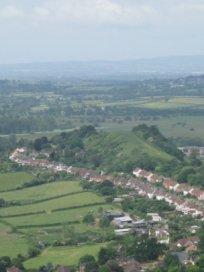
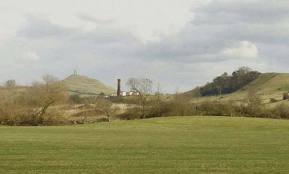
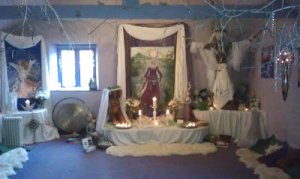
L to R: Wearyall Hill, Bride's Mound, Glastonbury Goddess Temple
This morning experience a Special Private Access Entrance at the Chalice Well,
a pilgrimage site for many thousands of years for those seeking physical and emotional
healing from its iron-red waters, thought by some to represent the blood of the Goddess.
During the Middle Ages and in the 18th Century Glastonbury gained a great reputation as a
place of healing, and the Well was one of the centers where pilgrims came to take
advantage of its curative powers. Today the waters of both the Red Spring
and the adjoining White Spring still have a reputation for their
cleansing, healing and transformative qualities. Like pilgrims who have come here since
ancient times seeking physical and emotional healing from its iron-red waters blessed by
the Goddess, we too may receive our healings! At the bottom of the garden we stop at the
pool that has water flowing into it through a series of flowing steps from the body of the
Goddess Herself. We then continue to the main well, with its cover in the shape of the
Vesica Pisces, one of the most fundamental symbols of sacred geometry, symbolizing the
Sacred Marriage, the divine union of the male and female energies. Here at this ancient
sacred place, Lynne and Michael will lead a meditation to reflect on Divine Union.
Then walk around
the corner for our private entrance at the Well House for the White Spring next door to the
Chalice Well. For thousands of years seekers have been drawn to the mythical Isle of
Avalon, which was once an island separated from the mundane world by an inland sea. From
its heart under the Tor, the water still rises and falls in profusion, presenting one of
the greatest mysteries of the Isle: two different springs, the Red Spring touched red from
iron and the White Spring, which is actually several springs that arise
from the Tor. They're mixed in a mixing chamber that is behind the cottage located above
the spring. One of these springs contains chalybeate water, similar to Chalice Well water,
which gives rise to some thoughts that the water from the Chalice Well may actually have
its source within the Tor. Once the water leaves the White Spring building it flows
underground in a completely separate plumbing system to the Chalice Well.
The building was initially constructed as a reservoir by the local water
supply company. It was used as a reservoir for a number of years, supplying most of
the town's water, until the pipes blocked up owing to high calcite deposits that built up
within them. In the 1980s and 90s it was used as cafe and a shop, and was
sold in 2003 to a benefactor who had no wish to commercialise it. He formed a local
commitee to manage it on a non profit basis. For a while it was an empty
space with the water flowing through a conduit in the floor. Then in 2009
the new pools were designed based on sacred geometry and
the dimensions of the building. Behind the building is a tunnel (now
sealed off) that leads into the Tor; how far is not known, but it's given rise to various
legends about it possibly being an entrance to the underworld.
So the Well House could be referred to as a subterranean cavern
within the Tor, lit only by one small skylight and the flickering of candles. Entering in
represents a powerful symbolic jouney from and through the darkness into the light,
with the healing waters of the White Spring flowing through it. The Celtic Goddess
Brigid, the Lady of Avalon, is the guardian whose ancient presence pervades this
sacred space. Inside there are three domed vaults, and beautiful bowed floors - like the
hull of a boat moored at the portal to the Otherworld. The constant temperature and
the sound of the perpetually flowing water make this a unique sacred space. We'll have the
opportunity to step into the pools, as well as time for a Sacred Ritual led by Michael and Lynne.
Return walking to town. Free time and lunch on your own.
OPTION:
For those who would like to experience the ancient energies at WearyAll
Hill and Bride's Mound, this will be a later afternoon
visit with Michael. WearyAll Hill (seen in the photo taken from
Glastonbury Tor) is where Joseph of Arimatheia on his arrival
from the Holy Land supposedly planted his staff, which flowered into a hawthorn tree.
Genetic testing of the surviving tree has shown it to be a species found in the Middle
East. Legend has it that Joseph landed here, rested on his staff, and it sprouted
branches and leaves. This old shamanistic tradition indicates that 'this is the place'.
The chances are that Glastonbury was well known at the time, and that he had either been
invited here or knew it could be a refuge, amongst people who would understand the early
Christians' plight. Tradition has it that he was a rich metals trader who traded with
Britain for tin from Cornwall and lead from the Mendip Hills just north of Glastonbury.
Bride's
Mound is a tiny little mound just near the foot of Wearyall Hill. Tiny it may be,
but its history is great, for legend has it that it was a gateway to Avalon
where pilgrims, arriving by boat from Ireland and Wales, would stay in vigil through the
night, before passing on up the processional way to Avalon. Arthur is said to have had a
vision of the great Goddess here, and Mary with her son, and St. Brigid of Ireland are
said to have stayed here. Hence the link with Bride (Brighde, Brigid).
Early dinner
on your own, or plan to have snacks at the B and B after our ceremony at the Goddess
Temple.
This evening we walk to High Street to the Glastonbury
Goddess Temple for a Goddess
Ritual and Meditation with Lynne
Orchard, Priestess of Avalon. She will offer our group a special initiation into
the age-old Goddess Mysteries that are connected to this area of ancient Avalon. What
special Gift of Spirit will The Lady bestow upon you? What wisdom will She gently whisper
to your Heart? Come in openness and humility...and receive!
Return walking to our B and B. Overnight
Glastonbury. Pilgrims Bed & Breakfast.
Day 5. Wednesday, August 10. Silbury Hill, West Kennett Longbarrow and Avebury (B)
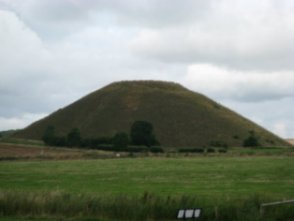
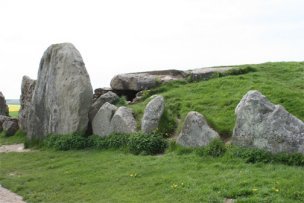
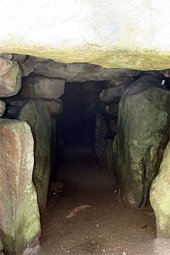 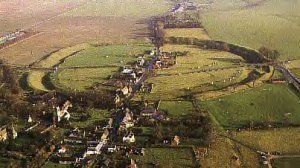
L to R: Silbury Hill, West Kennett Longbarrow, Entrance to West
Kennett Longbarrow, Aerial view of Avebury
After
breakfast we're off to begin to explore and experience the local sacred sites and ancient
mysteries! We begin our exploration of the area at the huge and mysterious Silbury
Hill, a grass-covered man-made chalk mound that is the biggest prehistoric
artificial mound in Europe. Evidence from radiocarbon dating indicates that Silbury was
constructed about 4,400 years ago in the Neolithic period. Its construction is estimated
to have involved roughly 4 million hours of work using 500,000 tons of material, mostly
chalk that was quarried and cleared from the surrounding terraces and ditches. Some people
see the Hill as a symbolic effigy of the ancient Mother Goddess that was associated with
fertility rituals which marked the course of the year. The festival of Lammas in August,
when it is thought Silbury was founded, celebrates the first fruits of the harvest.
Next we walk across
the highway to West Kennett Longbarrow, a
Neolithic tomb or barrow,. It's one of the most impressive and well-preserved burial
chambers in Britain. Archaeologists classify it as a chambered long barrow; It has two
pairs of opposing transept chambers and a single terminal chamber used for burial. The
entrance consists of a concave forecourt with a facade made from large slabs of sarsen
stones which were placed to seal entry. The construction of the West Kennet Long Barrow
began about 3600 BCE, which is some 400 years before the archaeologically-determined first
stage of Stonehenge, and it was in use until around 2500 BCE. This was at the same time as
the great stone circle at Avebury was begun, and may signify a change in the focus of
belief and religion. Michael
will lead a short meditation to connect with the Ancestors.
The mound has been damaged by indiscriminate digging, but archaeological excavations in
1859 and 1955-56 found at least 46 burials, ranging from babies to elderly persons. The
bones were disarticulated with some of the skulls and long bones missing. It has been
suggested that the bones were removed periodically for display or transported elsewhere
with the blocking facade being removed and replaced each time. It's thought that this tomb
was in use for as long as 1,000 years and at the end of this period the passage and
chamber were filled to the roof by the Beaker people with earth and stones, among which
were found pieces of Grooved ware, Peterborough ware and Beaker pottery, charcoal, bone
tools, and beads. Stuart Piggott, who excavated this mixture of secondary material,
suggested that it had been collected from a nearby 'mortuary enclosure' showing that the
site had been used for ritual activity long after it was used for burial.
Folklore & Legend: The mound is traditionally visited by a white
spectral figure accompanied by a white red-eared hound at sunrise on Midsummer's day.
There is a slim possibility that this tradition is a folk memory of a ritual event or at
least a time thought to have been significant in the use of the barrow. There is no doubt
that some traditions can become convoluted into folklore, and be passed down over the
centuries, whether this is the case with West Kennet Long Barrow has never been explored.
However, some people do notice a strange atmosphere in the darkened chamber. And
photographs taken inside the long barrow have revealed interesting phenomena…like the
mist seen in the photograph here. We’ll have time for a meditation to connect with
the Ancestors, here in their ancient final resting place.
We then continue to Avebury
World Heritage site. After a stop for lunch on your own at the site's cafeteria,
we begin our visit. Avebury is one of the world's largest and most complex monuments of
the Megalithic Age, an ancient Druidic initiation site of immense standing stones. Two
avenues of about 100 megaliths run out from Avebury. Today its mysteries are still being
explored and solved by multi-disciplinary scholars in archaeology, science and ancient
religion. As there are lunar and solar ley-lines that cross in this area, connect with
these powerful energies through ritual
facilitated by Michael to balance our own
masculine and feminine energies.
Time for some Retail Therapy at the Henge Shop, before returning
to Glastonbury. Dinner on your own.
Overnight Glastonbury. Pilgrims
Bed & Breakfast.
Day 6. Thursday, August 11.
Wells: Cathedral, Vicar's Close, Bishop's Palace; Free Time in Glastonbury
(B)
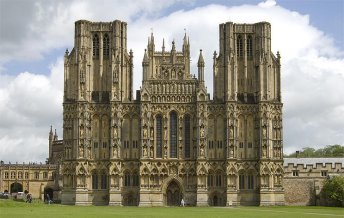 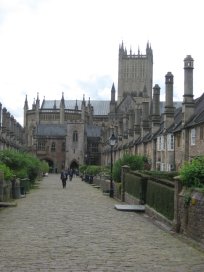
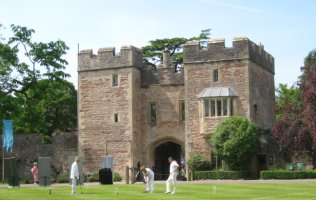 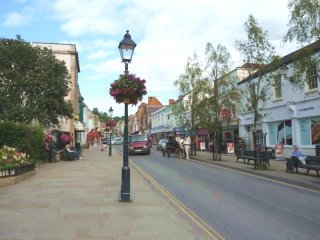
L to R: Wells - Cathedral, Vicar's Close, Bishop's
Palace; High Street in Glastonbury
This morning we journey to the city of Wells, the country's second smallest city. The name Wells derives from the three wells dedicated to
Saint Andrew, one in the market place and two within the grounds of the
Bishop's Palace and cathedral. There was a small Roman settlement around the
wells, but its importance grew under the Saxons when King Ine of founded a
minster church in 704CE, around which the settlement grew. Wells became a
trading center and involved in cloth making before its involvement in both
the English Civil War and the Monmouth Rebellion during the 17th century.
Our first stop is at the Cathedral of the Diocese of Bath and Wells,
which is situated next to natural wells where springs of water rise up from
beneath the Mendip Hills. This site has been a holy place for nearly 2000
years. The foundations of the building you see today were laid in 1185CE.
The Cathedral stands adjacent to the medieval Bishop’s Palace and Vicars’ Close,
the oldest continuously inhabited street in the country.
A major project completed in 2009 provided new facilities for choirs and
education, a dedicated interpretation area, a new entrance with shop and
restaurant, and has enabled the medieval cloister to be reopened to the
public. Enjoy the wonderful display of medieval statues on the West Front,
and inside the graceful scissor arches, the humorous carvings on the
pillars, and the deep colors of the stained glass. In this sacred place
hallowed by the prayer of centuries, pause for a moment of meditation to reflect on the gift of life.
After a short walk through the Vicar's Close, we visit the
Bishop's Palace, which has been the home of
the Bishops of the Diocese of Bath and Wells for 800 years. We'll explore
the medieval vaulted undercroft, the chapel and a long gallery. The Bishop's
House is still used as a residence and offices.
After lunch on your own at the onsite cafeteria, we return to Glastonbury.
You have free time this afternoon to
rest and relax or for some individual exploration in Glastonbury.
1. Visit the St. Margaret's Chapel / Magdalene Almshouses and Garden in
Magdalene Close in downtown, for a time of peaceful meditation, prayer and reflection. The
original structure was built in the 1070's but burned down in the great Abbey fire of
1184. The present one was re-built in 1444. Today its a sacred space of prayer, sanctuary
and spirituality.
2. Go into St. John's Church in the heart of town, dedicated to John the
Baptist, one of the original teachers of the Goddess Tradition. Here you can view the
beautiful stained glass window depicting Joseph of Arimathea holding two vials of
"Holy Grail."
3. Or take in some Retail Therapy as you wander along High Street in the
center of town, where shops full of new and used books on every topic you can imagine,
Celtic jewelry, clothes, artwork, crystals and gemstone and many more treasures abound!
Dinner on your own this evening.
Overnight
Glastonbury. Pilgrims Bed & Breakfast.
Day 7. Friday, August 12. Stonehenge
Private Entrance Inside the Circle; Visitor's Center;
Camelot Castle;
Farewell Dinner (B/D)
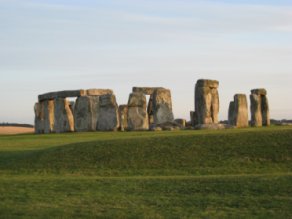 
L to R: Stonehenge and Cadbury Castle
We depart early morning to
Stonehenge
for our private entrance inside the
Stonehenge circle. There is much debate as to the age of Stonehenge, as well as who built
it. History says that the site was begun in the agricultural Neolithic Age and was
completed in the Early Bronze Age by early Britons known as the Beaker Folk, so called
because of beakers, drinking vessels, found in their grave goods. Around 1500 BCE some
disaster or systems collapse progressively brought the impressive Megalithic Age to an
end, not only here, but throughout the whole of Britain and Ireland. Although we can never
know exactly who the architects were who planned Stonehenge, the face sculptured into the
side of trilithon stone 54 does give us cause to wonder if he or she was so influential
that his/her facial features were placed here to be preserved forever as a representation
of the Divine Marriage, the concept of Sacred Marriage between an Earth Mother and Sky
Father, that was universal in early or primitive agricultural and Goddess-oriented
societies. Those who are sensitive to this massive temple claim that the megalithic blocks
are constantly radiating tremendous amounts of energy. Some say it is because the ancient
Druids turned themselves into the stones, while others assert that they hold the power of
innumerable Druid ceremonies held there in the past.
During our private time in the most ancient of sacred sites
Michael and Lynne
will facilitate
a
special ritual and meditation among the magical stones and their powerful energies. What ancient secrets
will be revealed to you? What will be your Gift of Spirit that you will
receive? Open your heart, mind, and soul…and receive!
Afterwards we return to the Visitor's Center, where you have time for a 2nd breakfast
on your own if you like, as well as to explore the museum and gift shop.
On our way back to Glastonbury we visit nearby Cadbury Castle,
an ancient hillfort that is a scheduled monument located on a plateau
surrounded by ramparts on the adjacent slopes of the limestone Cadbury Hill. The site was
excavated in the late 19th and early 20th century, in the 1960s and again in 1992,
revealing artifacts from human occupation and use from the Neolithic through the Bronze
and Iron Ages. The site was reused by the Roman forces and again from 470CE until some
time after 580CE. In the 11th century it temporarily housed a Saxon mint. Evidence of
various buildings at the site have been identified including a "Great Hall",
round and rectangular house foundations, metalworking, and a possible sequence of small
rectangular temples or shrines.
Known locally to aficionados of the Arthurian legends as Camelot, this is a place of legends. If there was an
historical Arthur, he is most likely to have lived in the 5th or 6th centuries, and this
is just the sort of hilltop stronghold that he would have inhabited. The first known
reference to Cadbury as Camelot is from the antiquarian John Leland who, in 1542, wrote:
"...At the very south end of the church of South-Cadbury standeth Camallate,
sometime a famous town or castle…. The people can tell nothing there but that they
have heard say Arthur much resorted to Camalat..."
As you walk among this ancient ruin, take some time to reflect and meditate upon the ancient ones who built it, and lived and died here. What message do you
receive?
Afterwards we return to Glastonbury. You have free time this afternoon to rest and relax or for some final individual exploration in Glastonbury.
Tonight enjoy the group Farewell Dinner, as you say your fond Good-byes to your fellow pilgrims.
Overnight Glastonbury. Pilgrims
Bed & Breakfast.
Day 8. Saturday, August 13. Group Transfer to London Heathrow Airport (B)
Morning group transfer to
London's Heathrow International Airport.
(IMPORTANT: Please book your flight to depart AFTER 2:00PM. Thank you.)
Note: This itinerary is subject to change due to conditions beyond our control.
OR, Continue to CORNWALL
See Below

Post-tour Extension to CORNWALL: Bodmin Moor, Tintagel &
Boscastle
Michael and Lynne Orchard
August 13 - 16, 2016
NOTE: This itinerary involves some long walks over rough terrain
and at times climbing a considerable number of stone steps.
Therefore it’s only suitable for those who are physically fit and able.
ITINERARY
Day 8. Saturday, August 13. To
Cornwall: Bodmin Moor & Tintagel (B)
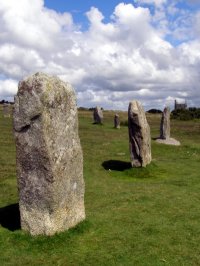

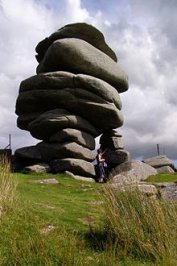
L to R: The Hurlers stone circles, Dozmary Pool,
The Cheesewring
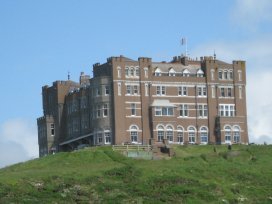
The Camelot Castle Hotel
Leave Glastonbury after an early breakfast with Michael
and Lynne Orchard and head down into Cornwall via mysterious and enigmatic Bodmin
Moor, a granite moorland 80 square miles in sizedateing from the Carboniferous
period. The name 'Bodmin Moor' is a relatively recent name, actually being an Ordnance
Survey invention of 1813! It was formerly known as Fowey Moor after the River Fowey which
rises within it. More than 200 Bronze Age settlements with enclosures and field patterns
have been recorded and many prehistoric stone barrows and circles lie scattered across the
moor. You'll have the opportunity today to visit some of these.
Our first stop is the famous Hurlers stone circles,
a Bronze Age Monument (c.1500 BCE) of three stone circles. The name "Hurlers"
actually derives from an age-old Cornish legend, in which men were playing Cornish hurling
on a Sunday and so were transformed into stones as a punishment. Just to the west of the
circles are two standing stones known as the Pipers. Local legend has it that they are the
figures of two men who played tunes on a Sunday and suffered the same fate - they were
also turned to stone. The stone circles have diameters of 115 ft, 138 ft and 108 ft.
Little is known about the original use/meaning of The Hurlers; the earliest mention of
them was by historian John Norden, who visited them around 1584. They were also described
by William Camden in his Britannia of 1586, but it wasn't until 1754 until the first
published and detailed description of the site by William Borlase.
Alexander Thom (1894 – 1985, a Scottish engineer most famous for his
theory of the Megalithic yard, categorization of stone circles and his studies of
Stonehenge and other archaeological sites) suggested borderline case alignments at the
Hurlers. He suggested two solar alignments of four stones with far
uprights. He Also suggested two stone-to-site alignments with Vega and Arcturus
and two other site-to-site alignments with Arcturus. Each stellar alignment was given with
tabulated declinations at a date some time in between the range of 2100 to 1500 BCE.
Next stop is The Cheesewring ancient hill settlement with its
‘hanging rocks.’ The location is a granite tor situated on Stowe's Hill. It's a
natural geological formation, a rock outcrop of granite slabs formed by weathering. The
name derives from the resemblance of the piled slabs to a "cheesewring", a
press-like device that was once used to make cheese.
Engjoy lunch on your own with the group in the nearby village café.
Then continue on to remote Dozmary Pool, which originated in the
post-glacial period. The outflow from the pool is one of the sources of the River Fowey.
At one time the name was often spelled 'Dozmaré': At the end of the 19th century it was
described by Sabine Baring-Gould as abounding in fish and surrounded by numerous remains
of the working of flint in the Stone Age.
According to the Arthurian romances, it's here that King Arthur rowed out to the Lady of
the Lake and received the sword Excalibur. The pool is also the place where Bedivere
returned Excalibur as Arthur lay dying after the Battle of Camlann.
Arrive late afternoon in Tintagel and check in at the Camelot
Castle Hotel, home for three nights. Sitting proudly in Tintagel overlooking the
Atlantic Ocean and Tintagel Castle, the stunning hotel offers rooms with magnificent
panoramic views over the rugged Cornish coastline from Hartland Point in the North, to
Trevose Head in the South. Our traditional castle rooms in a classical Victorian style
with en-suite shower facilities overlooking the Atlantic. The Hotel, which is fully
licensed, offers excellent cuisine. Enjoy superb freshly-cooked food made using local
produce in the restaurant while also enjoying the equally superb panoramic views. Weather
permitting, you can also eat & drink al-fresco on the terrace. There is a grand piano
for any musician who would like to entertain. In the Arthurian-style bar you can relax for
a quiet drink and look out over the Atlantic ocean. Or enjoy music for your comfort and
entertainment in the dance hall. You can sit and talk with friends at King Arthur's Round
Table. You can also write a letter to Merlin and drop it in the box on the table.
Dinner on your own with the group at the hotel
restaurant. Overnight Tintagel.
Camelot Castle Hotel.
Day 9. Sunday, August 14. Tintagel: Arthur’s Hall of Chivalry, Tintagel Castle;
Merlin’s Cave (B)
  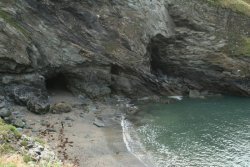
L to R: Tintagel Castle, Arthur's Hall of Chivalry, Merlin's Cave
After breakfast we
head into Tintagel.The first stop is Arthur’s
Hall of Chivalry, an atmospheric and historic building built in the 1930s by
Frederick Thomas Glasscock as the home of the Order of the Fellowship of the Knights of
the Round Table of King Arthur. Everything in these halls is based upon the Arthurian
Romances; all of the art and symbols are directly associated with King Arthur and the
Knights of the Round Table. We enter The Halls through the gift shop and continue through
to the Small Hall to view a brief audio visual presentation of the story of Arthur. We
leave and pass along a corridor into the Hall of Chivalry. Here we see 125 shields of
granite, set along its full length, representing the passage from darkness into light.
Granite is also used in the huge canopy over the throne, weighing six tons and supported
by nine massive granite pillars. There is also a granite Round Table, along with two
wooden ones. The Halls contain seventy three beautiful stained glass windows designed and
crafted by Veronica Whall during 1930 – 33. The galleries of The Hall of Chivalry
contain ‘The Windows of the Knights’. Each Knight of the Round Table is
illustrated by his unique shield depicted in the windows. By each window, the
Knight’s story is told in words. The Hall of Chivalry holds eighteen windows
portraying the principal virtues which the Knights of the Round Table agreed to observe.
In the Hall of Chivalry, these virtues are graded in quality, starting with the less
spiritual ones such as Strength, Perseverance and Obedience, through to those considered
more spiritual such as Purity, Faith and Love.
Then you have free time for exploration on your own and/or shopping in some of the quaint
and interesting local shops. Gather in town and go with the group for lunch on your own at
theTintagel Castle on-site cafe.
Afterwards you’re off to explore Tintagel Castle, on a rocky
windswept headland above the sea, surrounded on three sides by the Atlantic Ocean. The
name Tintagel derives from Din Taggel, meaning "fortress of the narrow
entrance". Historically it would appear that Tintagel was an important trading post
from late Roman times until it was abandoned at the end of the 7th century. Around 1230, a
castle was built at Tintagel by Richard, Earl of Cornwall and son of King Henry III. When
Geoffrey of Monmouth wrote about it in the History of the Kings of Britain in 1136, the
1230 Tintagel Castle would not have been there and legend would have been his main source
of what had happened on the island stronghold.
Is it the birthplace of King Arthur? Legend has held that this is the place where
Uther Pendragon mated with Arthur's mother, Igraine, and conceived the future king. Arthur
is reputed to have been born here. Excavations in the 1930's uncovered 5th to 6th century
Dark Age settlement and monastic remains. Whether King Arthur was born there or not is
impossible to tell, but archaeological evidence does make Tintagel a plausible site for
such a kingdom at the supposed time of King Arthur. The unique artifacts at Tintagel
emphasize its dominance as a royal citadel and Mediterranean contact during the 5th and
6th centuries. An archeological find was made there in July 1998 when a team from Glasgow
University uncovered a sixth-century slab with this inscription: PATER COLI AVI FECIT
ARTOGNOV. This has been translated to mean "Artognou, father of a descendant of
Coll, has had this [building] made". The name "Artognou" was probably
pronounced "Arthnou." Art and Arth were fairly common prefixes to the names of
Dark Age rulers. Some researchers believe that the stone is probably just another piece of
evidence that Tintagel was a wealthy Dark Age stronghold. It confirms that there was a
relatively well-educated and wealthy person there in the sixth century with a name that
may have sounded like Arthur. It does not prove that King Arthur himself lived at
Tintagel. But the mystery lives on! As we walk through these ancient ruins, keep your
Third Eye open to see between the veils to those days long past. Perhaps you'll glimpse
Arthur and receive a message from him. We’ll find a quiet and peaceful area of the
site for a group meditation facilitated by Michael
and Lynne.
Tide and time allowing, descend to the beach to Merlin's Cave, located
under the rocks close to Tintagel Castle. If not, view it from above. Legend maintains
that the spirit of the great Druid Merlin still inhabits this lonely place. It’s very
atmospheric; you might imagine Merlin approaching, with his staff held up to light up the
darkness of the cave. If you're able to enter, take time to meditate
and connect with the energies that reach out to us from the misty past.
Return to the hotel.
Dinner on your own with the group at the hotel restaurant.
Overnight Tintagel. Camelot Castle Hotel.
Day 10. Monday, August 15. Tintagel:
St Nectan’s Glen; Boscastle Witchcraft Museum (B)


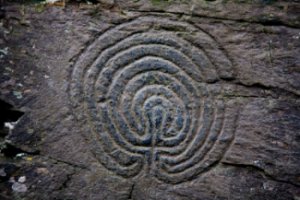 L to R: Witchcraft Museum in Boscastle, Waterfall at
St. Nectan's Glen, Laybrinth Rock Carving in Rocky Valley
After breakfast we
depart for Rocky Valley to see
the possibly ancient labyrynth rock carvings and to view the dramatic
meeting of the Trevillet River and the sea. Rock carvings discovered in 1948 are believed
by some to be from the early Bronze Age (1800-1400 BCE). The two carvings take the form of
circular labyrinths. Modern scholars believe that, as the labyrinths were carved on a
quarried wall with a metal tool, they are likely to be less than three hundred years old.
In 2005 it was claimed that another carving can be seen, much fainter than the first two,
leading to speculation that the two well-defined carvings are copies of ones that are much
earlier: this has yet to be proved.
Afterwards visit St Nectan’s Glen, an area
of woodland in Trethevy near Tintagel, which is held sacred by many people who visit it.
Stretching for around one mile along both banks of the Trevillet River, the glen's most
prominent feature is St Nectan's Kieve, a spectacular 60 ft. waterfall. The walk through
woodland takes us alongside a stream with many places to stop and take in the calming
beauty of the water. At the amazing and powerful waterfall, we may be blessed to
experience its legendary healing qualities.
L to R: Witchcraft Museum in Boscastle, Waterfall at
St. Nectan's Glen, Laybrinth Rock Carving in Rocky Valley
After breakfast we
depart for Rocky Valley to see
the possibly ancient labyrynth rock carvings and to view the dramatic
meeting of the Trevillet River and the sea. Rock carvings discovered in 1948 are believed
by some to be from the early Bronze Age (1800-1400 BCE). The two carvings take the form of
circular labyrinths. Modern scholars believe that, as the labyrinths were carved on a
quarried wall with a metal tool, they are likely to be less than three hundred years old.
In 2005 it was claimed that another carving can be seen, much fainter than the first two,
leading to speculation that the two well-defined carvings are copies of ones that are much
earlier: this has yet to be proved.
Afterwards visit St Nectan’s Glen, an area
of woodland in Trethevy near Tintagel, which is held sacred by many people who visit it.
Stretching for around one mile along both banks of the Trevillet River, the glen's most
prominent feature is St Nectan's Kieve, a spectacular 60 ft. waterfall. The walk through
woodland takes us alongside a stream with many places to stop and take in the calming
beauty of the water. At the amazing and powerful waterfall, we may be blessed to
experience its legendary healing qualities.
Who Was St Nectan? Around 500CE St Nectan built his small sanctuary
beside the Trevillitt River, just above the waterfall and the kieve (Cornish for 'basin').
Tradition has it that behind the chapel was a tower where he hug a silver bell that he
rang to warn sailors of submerged rocks on the treacherous Cornish coast, or to summon
help from the Celtic monastery near Tintagel castle for vessels in distress. From his
vantage point he would have been able to see both coast and castle from the top of his
tower. Or, perhaps he rang it just to assure sailors that he was praying for their safety.
As the end of his life approached, the area was split apart by bitter differences between
the older Celtic and the newer Roman faiths. St. Nectan prophesied the return of the
older, simpler faith, vowing that his bell should never ring for unbelievers; he carried
it to the bank above the kieve and dropped it into the basin. It's said that his bell
still tolls today. When he died, two strange ladies who are believed to have been his
sisters came and, acting upon his wishes, they placed his body, the sacramental vessels
and other treasures into an oak chest. They diverted the waters of the fall, dug a grave
in the river bed below the Kieve and buried the chest. The river turned back to its
natural course and now flows over the saint's grave. We’ll take time here for
exploration of this place of incredible natural beauty and peace, as well as individual
meditation.and reflection.
Continue to Boscastle. Enjoy lunch on your own with the group in one of
the harbor-side cafes in this small village and fishing port of Boscastle, a few miles
northeast of Tintagel. The village with its picturesque harbor is a very popular tourist
destination. Much of the land in and around Boscastle is owned by the National Trust,
including both sides of the harbor. The Forrabury Stitches, high above the village are
ancient "stitchmeal" cultivation plots. Large areas of the Valency Valley are
known for its connections to the novelist and poet Thomas Hardy. The National Trust runs a
shop at the harbor, and a visitor center in the Old Smithy.
After lunch visit the Museum of Witchcraft, which houses the world's
largest collection of witchcraft related artifacts and regalia dating from prehistory to
today. This very unique privately-owned museum has been in existence since 1951 when it
first opened on The Isle of Man. It's been in Boscastle since 1961 and is amongst
Cornwall's most popular museums. It also houses a large library with around 5,000 books
which is used by researchers from the UK and around the world.
Return to Tintagel. Free time.
Dinner
on your own with the group at the hotel restaurant.
Overnight Tintagel.
Camelot Castle Hotel.
Day 11. Tuesday, August 16. Group
Transfer to London Heathrow Airport (B)
Morning group transfer to London's Heathrow International Airport
If you wish to be dropped at a Heathrow hotel instead, and individual supplement will be
payable to Michael.
IMPORTANT: Please book your flight to depart AFTER 7:00PM, as we may not arrive at
Heathrow before 4.00PM. Thank you.
Service ends on arrival at Heathrow.
Note: This
itinerary is subject to change due to conditions beyond our control.

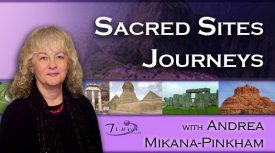
From the Archives
ENGLAND:
The Sacred Mysteries of Stonehenge and Avalon
Guest:
Nicholas Mann, author of Energy Secrets of Glastonbury Tor and The Isle of
Avalon
To listen to an Mp3 recording of this program, Click here

A
Few Words from Sacred Sites Journeys Pilgrims to ENGLAND
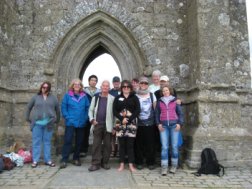
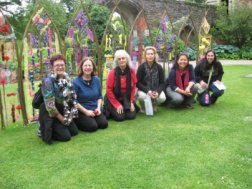 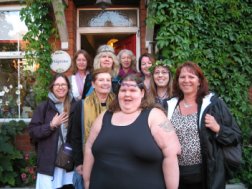 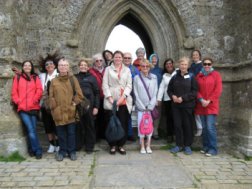
Some of our recent Sacred Sites Journeys groups in ENGLAND
L to R: June 2012, June/July 2013, August 2014, July 2015
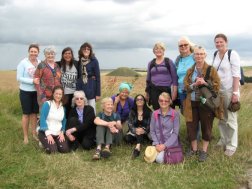 Michael
Orchard is a national treasure! His knowledge of the history of the various sites we
visited helped them to come alive for all of us! His supportive, compassionate and gentle
manner he displayed with each person in the group assisted us all to create a group
synergy that was both safe and dynamic. Michael and Lynne, our Priestess of Avalon, led
profoundly spiritual rituals and meditations. We were all able to easily connect with the
Ancestors, the various Gods & Goddesses, as well as those places within ourselves that
were calling for transformation. Andrea Mikana-Pinkham is a seasoned and very able tour
director who made sure that everything went very smoothly, so that we had time at each
site to make our connections, as well as have free time to enjoy Glastonbury. Thanks so
much to all of you for a lifetime spiritual adventure that I'll never forget! - Anonymous by request Michael
Orchard is a national treasure! His knowledge of the history of the various sites we
visited helped them to come alive for all of us! His supportive, compassionate and gentle
manner he displayed with each person in the group assisted us all to create a group
synergy that was both safe and dynamic. Michael and Lynne, our Priestess of Avalon, led
profoundly spiritual rituals and meditations. We were all able to easily connect with the
Ancestors, the various Gods & Goddesses, as well as those places within ourselves that
were calling for transformation. Andrea Mikana-Pinkham is a seasoned and very able tour
director who made sure that everything went very smoothly, so that we had time at each
site to make our connections, as well as have free time to enjoy Glastonbury. Thanks so
much to all of you for a lifetime spiritual adventure that I'll never forget! - Anonymous by request
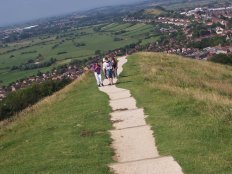 Glastonbury/Avalon is a beautiful and magical place – a sacred site in
and of itself, and near to so many other sacred sites in England. I would recommend this
tour to anyone who is called to it. There is so much to explore and experience, from the
ruins in Tintagel to the crop circles! The private entrances to the Chalice Well and
Stonehenge were highlights of this tour for me. These are things that most people do not
get to experience, and this is what makes Sacred Sites Journeys special. Koko Newport is a
delightful and fascinating woman, and I thoroughly enjoyed and benefitted from time spent
with her. It was also incredible to have Nicholas Mann as a speaker. His knowledge of the
history and legends of Glastonbury/Avalon held us all in thrall during his lecture. I was
privileged to have a reading with him. I hope to return to Glastonbury in the not too
distant future, either as part of a tour or on my own, and I certainly will be interested
in Sacred Sites Journeys to Ireland and Scotland, too! From there, who knows? The world
has opened up to me! - Jeanne
D., IL Glastonbury/Avalon is a beautiful and magical place – a sacred site in
and of itself, and near to so many other sacred sites in England. I would recommend this
tour to anyone who is called to it. There is so much to explore and experience, from the
ruins in Tintagel to the crop circles! The private entrances to the Chalice Well and
Stonehenge were highlights of this tour for me. These are things that most people do not
get to experience, and this is what makes Sacred Sites Journeys special. Koko Newport is a
delightful and fascinating woman, and I thoroughly enjoyed and benefitted from time spent
with her. It was also incredible to have Nicholas Mann as a speaker. His knowledge of the
history and legends of Glastonbury/Avalon held us all in thrall during his lecture. I was
privileged to have a reading with him. I hope to return to Glastonbury in the not too
distant future, either as part of a tour or on my own, and I certainly will be interested
in Sacred Sites Journeys to Ireland and Scotland, too! From there, who knows? The world
has opened up to me! - Jeanne
D., IL
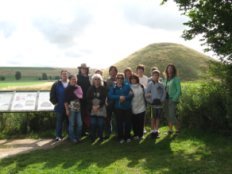 Traveling to Glastonbury is an experience you will never
forget. This sacred land will transform you and your life. You will quickly understand why
so many people have made pilgrimage to this sacred land over the ages. These sacred sites
are powerful and breathtaking. From Stonehenge to the Chalice Well each place is uniquely
inspirational and transformational. And of
course you are truly blessed to have Andrea serve as your guide. Helping others travel on
these spiritual journeys is truly her love and it is reflected in all of her actions. It
is her goal to help you have the most meaningful experience possible. Scared Site Journeys
have helped me discover myself and created dreams I never thought possible. Thank you
Andrea! - Michelle Z, MN Traveling to Glastonbury is an experience you will never
forget. This sacred land will transform you and your life. You will quickly understand why
so many people have made pilgrimage to this sacred land over the ages. These sacred sites
are powerful and breathtaking. From Stonehenge to the Chalice Well each place is uniquely
inspirational and transformational. And of
course you are truly blessed to have Andrea serve as your guide. Helping others travel on
these spiritual journeys is truly her love and it is reflected in all of her actions. It
is her goal to help you have the most meaningful experience possible. Scared Site Journeys
have helped me discover myself and created dreams I never thought possible. Thank you
Andrea! - Michelle Z, MN
I absolutely loved the tour, had many powerful meditations, visions and I would
most definitely do another of your tours. - Kathy S, CT
The meditation at Stanton Drew was very peaceful and
profound, and I thought one of the more spiritual moments of the tour. I can’t say
enough good things about Clare & Brian and Pilgrims Bed and Breakfast in Glastonbury!
Wonderful! - Anonymous by
request
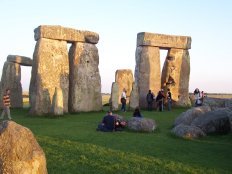 The
spiritual pilgrimage to Glastonbury was excellent! My most meaningful experiences were at
Stonehenge, the Chalice Well, and inside the crop circle. Andrea did an excellent job as
our Tour Director, and facilitator of the meditations. AND, the food at the welcome dinner
was really good! The
spiritual pilgrimage to Glastonbury was excellent! My most meaningful experiences were at
Stonehenge, the Chalice Well, and inside the crop circle. Andrea did an excellent job as
our Tour Director, and facilitator of the meditations. AND, the food at the welcome dinner
was really good!
Vicki K, OH
Glastonbury
is an amazing place that touches everyone. The B&B was PERFECT. The hosts were very
friendly and yet accommodating and professional. Weren't we lucky with the weather? Koko
Newport was also wonderful. She was relaxed, well informed, and made us feel like family
at her business site with meals and hospitality. She was also excellent in letting nature
take its course----friendly, while dropping little nuggets of wisdom when asked. -
Beth G, WI
The sacred journey was a
great introduction to Glastonbury and its many gifts. It had the right amount of scheduled
time with ample free time. I found Andrea to be very conscientious of the individuals and
the group, without trying to micromanage or force and experiences.
The provided information left room for my own conclusions and perceptions to integrate in
the way it was meant to. This was the perfect 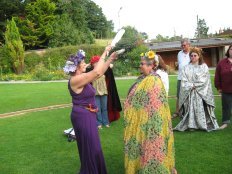 combination of introduction and
detail to help one start the integration process into the Magick and mysteries of our
foundations. The experience was a beautiful and fulfilling experience that opened
my eyes to new things. Humorous, fun and intellectual - my mind was fed and I was
left wanting more information, more experience and more time. I thoroughly enjoyed the
Nicholas Mann's visit and discussion; his kind, compassionate and integrity of
manner inspired me to think, to feel and most importantly - to remember. - Jennie
K, ME combination of introduction and
detail to help one start the integration process into the Magick and mysteries of our
foundations. The experience was a beautiful and fulfilling experience that opened
my eyes to new things. Humorous, fun and intellectual - my mind was fed and I was
left wanting more information, more experience and more time. I thoroughly enjoyed the
Nicholas Mann's visit and discussion; his kind, compassionate and integrity of
manner inspired me to think, to feel and most importantly - to remember. - Jennie
K, ME
This Goddess-oriented journey was all I could have dreamed of and more. It
was a healing pilgrimage for myself and my soul. The visit to the Chalice Well and the
ritual with Koko were very meaningful and moving for me. Stonehenge and the Tor were
exceptional! I loved Andrea's perceptions, and also her channeling session. Made a lot of
sense! I felt she was very plugged into all of us and our issues. She was a ray of
sunshine! - Raven M, ME

INCLUSIONS
Your Sacred Sites
Journey to ENGLAND Includes:
-
Roundtrip group transfers between Heathrow International Airport and Bed and Breakfast in
Glastonbury (Note: If you do not fly into Heathrow and/or do not meet the group for
the transfers, then you are responsible to make your own arrangements for this
transportation to and from your B and B. There is no refund for not taking the group
transfers.)
- Transportation in air-conditioned motorcoach
- 7 Night's accommodations in First Class Bed & Breakfast
- Daily breakfast (special diets accommodated), 2 dinners
- Welcome and Farewell Dinners (special diets accommodated)
- Sightseeing tours as per itinerary, including entrance fees
- Escorted on arrival at London Heathrow Airport by Sacred Sites Journeys Director Andrea
Mikana-Pinkham
- Pre-Paid Gratuities for driver/guide, waiters at group meals, etc.
SPECIAL FEATURES:
- Travel in a smaller group of other spirit-centered people
- Spiritual Tour Guide and Ceremonialist: Michael Orchard
- Ceremonialist: Lynne Orchard, Priestess of Avalon
- Ceremonies & meditations at sacred sites facilitated by Michael Orchard and Lynne
Orchard
- Private group entrance at Stonehenge for sacred ceremony and meditation
- Private group entrance at the Chalice Well
- Private group entrance into the Well House at the White Spring, next to the Chalice Well
- Private group entrance at the Glastonbury Goddess Temple
- Private group entrance at the Cross Bath in Bath
- Welcome and Farewell Dinners
- Avebury, Silbury Hill and West Kennett Longbarrow
- Glastonbury Tor
- Free time in Glastonbury
- Bath: Walking Tour and Roman Baths
- Wells: Wells
Cathedral & Bishops Palace
- Cadbury Castle, legendary site of Camelot
NOT
INCLUDED:
-
Roundtrip international flight to England (Arrive/Depart London Heathrow Airport)
-
Meals not included, as indicated in the itinerary
- Cost to obtain valid passport
- Any items of a personal nature such as laundry, drinks, internet access and telephone
calls. Any item that is not specifically detailed on the Sacred Sites Journeys website or
final trip itinerary
Cornwall Extension Inclusions:
- Transportation in air-conditioned motorcoach
- 3 Night's accommodations at Camelot Castle Hotel in a seaview room with private bath
- Daily buffet breakfast
- Sightseeing tours as per itinerary, including entrance fees
- Escorted by Tour Guides Michael & Lynne Orchard
- Pre-Paid Gratuities for driver/guide
SPECIAL FEATURES:
-
Travel in a smaller group of other spirit-centered people
- Bodmin Moor: The Hurlers Stone Circles, the Cheesewring, Dozmary Pool
- Tintagel Castle, the legendary birthplace of King Arthur
- Arthur’s Hall of Chivalry
- Merlin’s Cave (Dependent on the tides)
- St. Nectan’s Glen
- Boscastle: Witchcraft Museum
- Rocky Valley
- Free time in Tintagel
NOT INCLUDED:
-
Meals not included, as indicated in the itinerary
- Cost to obtain valid passport
- Any items of a personal nature such as laundry, drinks, internet access and telephone
calls. Any item that is not specifically detailed on the Sacred Sites Journeys website or
final trip itinerary
 PRICING
This
tour is LAND ONLY. You are responsible to book your international flights to and from
London, England.
PRICING
This
tour is LAND ONLY. You are responsible to book your international flights to and from
London, England.
ARRIVAL: Please arrive in London at Heathrow International Airport on
Saturday, August 6, 2016 by 8:00AM in order to connect with
our 11:00AM group transfer from the airport to Glastonbury.
DEPARTURE - Main Tour: For your departure at London's Heathrow Airport on Saturday,
August 13th, please book your international flight to depart at 2:00PM or later.
DEPARTURE
- Cornwall Extension: For your
departure at London's Heathrow Airport on Tuesday, August 16th,
please book your international flight to depart at 7:00PM or later.
MAIN TOUR: Per Person, double occupancy, land only:
$1,689.00
- for payments via check or
bank wire transfer
ROOMMATES:
Would you like to meet and make a new friend
on your journey? If you're not traveling on the journey with anyone you know, and would
like for SSJ to try to match you up with a suitable roommate, we'll be happy to try to do
so. Over the last 21 years we've been operating these spiritual pilgrimages we've seen
many people become friends for life. (As well, we've had several marriages result from
people meeting on our journeys.) Be open! Be flexible! It will be a rich and wonderful
experience!
Single Room Supplement
$225.00 - for payments via check
or
bank wire transfer
Per our Terms and Conditions, we will hold the registration for the trip open
until 30 days before the departure date (or later if possible) in order to try to match
you with a roommate. If by that date we have not been able to do so, you will be
responsible to pay the single room supplement fee. You will have a better chance of being
matched with a roommate if you register early.
CORNWALL EXTENSION: Per Person, double occupancy, land only:
$1129.00 - for payments via check
or
bank wire transfer
Single Room Supplement
$69.00 - for payments via check
or
bank wire transfer
 REGISTRATION
REGISTRATION
TOUR REGISTRATION IS CLOSED!
This Sacred Sites Journey to ENGLAND is a
go!
Our spiritual journey begins on August 6, 2016
as our group
gathers at London Heathrow Airport to transfer to Glastonbury.
Questions?
Email info@SacredSitesJourneys.com
Or, call our office at 888 501-3853 (Toll free in the US) or 928 284-2384

If you'd like to receive our Monthly Sacred Sites
Journeys E-Newsletters, please Sign Up Here!
Newsletters are sent out about once a month.
Occasionally you may also receive an e-news bulletin about a specific journey or event.
We will not sell or share your
information with any other company or individuals.
You can easily un-subscribe at any time.

NOTE: All photos and text on this webpage are the
Copyright of Sacred Sites Journeys/ Heartlight Fellowship.
Sacred Sites Journeys is NOT
affiliated with any other sacred travel company.
Other sacred travel companies offering
spiritual pilgrimages similar to ours
are using our text and photos. We did not give them permission to do so.
We believe that karma is very efficient, and that those who are not in integrity
will swiftly reap the negative benefits of such actions.
Back to
top |
 GLASTONBURY: The Chalice Well, fountainhead of the Red
Spring
GLASTONBURY: The Chalice Well, fountainhead of the Red
Spring











 L to R: Witchcraft Museum in Boscastle, Waterfall at
St. Nectan's Glen, Laybrinth Rock Carving in Rocky Valley
After breakfast we
depart for Rocky Valley to see
the possibly ancient labyrynth rock carvings and to view the dramatic
meeting of the Trevillet River and the sea. Rock carvings discovered in 1948 are believed
by some to be from the early Bronze Age (1800-1400 BCE). The two carvings take the form of
circular labyrinths. Modern scholars believe that, as the labyrinths were carved on a
quarried wall with a metal tool, they are likely to be less than three hundred years old.
In 2005 it was claimed that another carving can be seen, much fainter than the first two,
leading to speculation that the two well-defined carvings are copies of ones that are much
earlier: this has yet to be proved.
Afterwards visit St Nectan’s Glen, an area
of woodland in Trethevy near Tintagel, which is held sacred by many people who visit it.
Stretching for around one mile along both banks of the Trevillet River, the glen's most
prominent feature is St Nectan's Kieve, a spectacular 60 ft. waterfall. The walk through
woodland takes us alongside a stream with many places to stop and take in the calming
beauty of the water. At the amazing and powerful waterfall, we may be blessed to
experience its legendary healing qualities.
L to R: Witchcraft Museum in Boscastle, Waterfall at
St. Nectan's Glen, Laybrinth Rock Carving in Rocky Valley
After breakfast we
depart for Rocky Valley to see
the possibly ancient labyrynth rock carvings and to view the dramatic
meeting of the Trevillet River and the sea. Rock carvings discovered in 1948 are believed
by some to be from the early Bronze Age (1800-1400 BCE). The two carvings take the form of
circular labyrinths. Modern scholars believe that, as the labyrinths were carved on a
quarried wall with a metal tool, they are likely to be less than three hundred years old.
In 2005 it was claimed that another carving can be seen, much fainter than the first two,
leading to speculation that the two well-defined carvings are copies of ones that are much
earlier: this has yet to be proved.
Afterwards visit St Nectan’s Glen, an area
of woodland in Trethevy near Tintagel, which is held sacred by many people who visit it.
Stretching for around one mile along both banks of the Trevillet River, the glen's most
prominent feature is St Nectan's Kieve, a spectacular 60 ft. waterfall. The walk through
woodland takes us alongside a stream with many places to stop and take in the calming
beauty of the water. At the amazing and powerful waterfall, we may be blessed to
experience its legendary healing qualities.